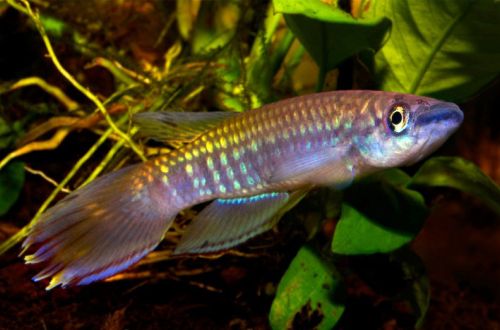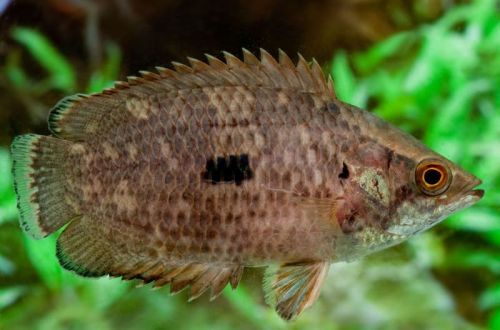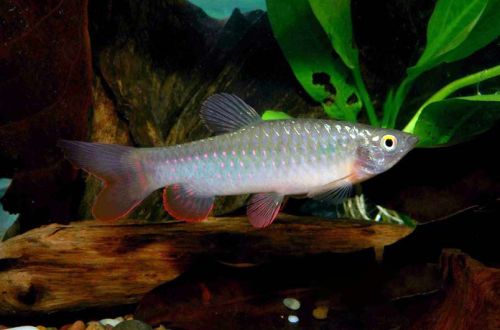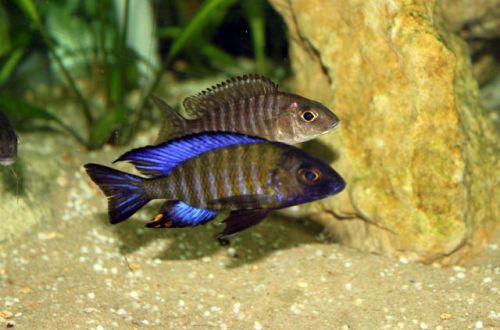
Tape Epiplatis
Epiplatys fasciolatus or Ribbon Epiplatis, scientific name Epiplatys fasciolatus, belongs to the Nothobranchiidae family. Beautiful rainbow fish, combining bright shades of pink and green. Often confused with “Asian pike” for their external similarity, however, this species comes from the African continent.

Habitat
It comes from the waters of North-West Africa from the region limited by the coastal strip from Guinea-Bissau to western Liberia. Inhabits freshwater swamps and small tributaries of rivers with rich vegetation. Depending on the population, the habitat ranges from grassy savannah to rainforest.
There are several groups of this species, designated by the region of distribution, for example, the Conakry group, Freetown, Monrovia, etc. – these are large cities in the vicinity of which Epiplatis lives. Many professional breeders, in order to preserve the genus, avoid crossing fish from different places, and therefore make additional clarifications.
Description
An elongated body with large anal and dorsal fins, both shifted closer to the tail, which helps Epiplatis to make quick jerks from a place. Males are somewhat large and brightly colored; females look rather modest against their background. The colors are iridescent, pink, blue and greenish shades prevail in it, depending on the region of origin.
Food
They belong to carnivorous species, in nature they prey on small terrestrial and aquatic invertebrates and various zooplankton. In a home aquarium, it is recommended to serve meat products (brine shrimp, daphnia, bloodworm, grindal worm, etc.) in combination with dry food. Adults are able to accept insects such as flies, fruit flies, mosquitoes, however, before this, a portion of dry flakes from plant components should be given so that their digestive system can better cope with the chitinous cover of insects.
Maintenance and care
A couple of fish will feel great in an aquarium with a volume of about 100 liters, less is acceptable, but excessive tightness will not lead to anything good. The substrate is soft sandy with several shelters in the form of snags, intertwined tree roots or branches. The addition of dried fallen leaves will emphasize the natural look and also enrich the water with humic substances that are characteristic of their natural habitat. Alder cones can be used instead of leaves. Foliage and cones should be updated periodically to prevent rotting. Since Epiplatis fasciolatus prefers subdued lighting, the choice of plants is significantly limited. It is allowed to use areas with dense vegetation from shade-loving plants and a few floating on the surface.
A set of equipment is standard for most aquariums: a filtration system, an aerator, a heater and lighting fixtures. Maintenance comes down to a weekly renewal of part of the water with fresh water, cleaning the glass from organic deposits and cleaning the soil with a siphon as needed. The latter is performed very carefully and not often, so as not to damage the colony of beneficial nitrifying bacteria.
Behavior
Peaceful friendly species, compatible with other fish of similar size and temperament. Large and/or aggressive species should be avoided. He gets along well with his relatives, paired content or in a small group is allowed.
Fish diseases
In favorable appropriate conditions, health problems do not arise. The main cause of ailments is the state of the environment; in a neglected aquarium with old dirty water, the risk of developing diseases increases significantly. Symptoms can be different, more about the symptoms and treatment methods in the section “Diseases of aquarium fish”.





